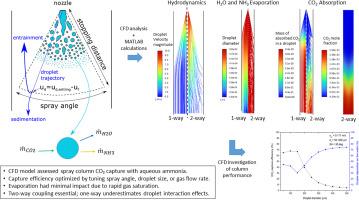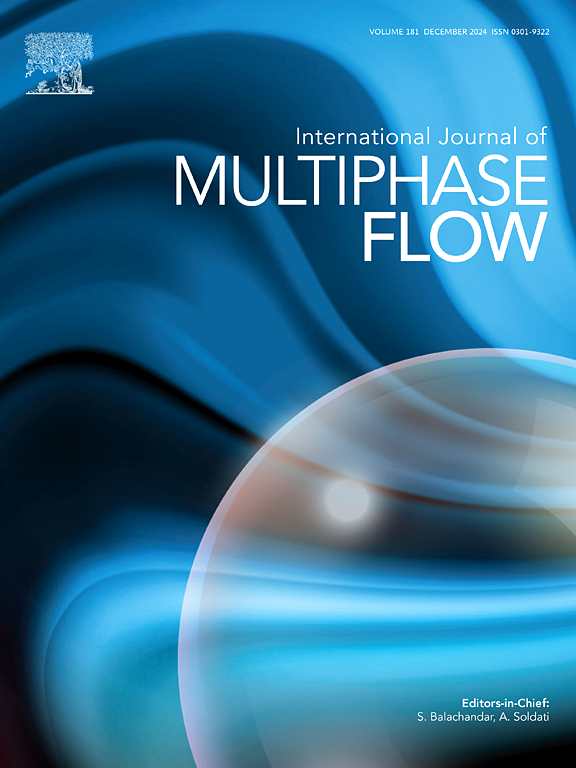含水氨和全锥雾化器喷雾塔中CO2捕获的数值模拟
IF 3.8
2区 工程技术
Q1 MECHANICS
International Journal of Multiphase Flow
Pub Date : 2025-08-05
DOI:10.1016/j.ijmultiphaseflow.2025.105405
引用次数: 0
摘要
在喷雾塔中使用氨水进行化学吸收是一种很有前途的二氧化碳燃烧后捕获方法,是碳捕集与封存(CCS)方法的关键步骤。然而,该过程对雾化和随后的液滴流体动力学高度敏感。为了研究喷雾参数对塔柱性能的影响,我们对液滴流体力学、蒸发和CO2吸收进行了MATLAB计算和CFD模拟。蒸发用无限电导率模型计算,吸收用经验模型求解。通过液滴末端沉降速度和液滴停止距离的概念,揭示了液滴直径对液滴夹带和壁面沉积的影响。通过MATLAB计算确定的最优参数的捕集效率为67%,通过调节喷雾角度或降低气流速度可将捕集效率进一步提高到74%。喷雾柱的CFD模拟强调了双向耦合模拟的必要性,因为喷雾会显著影响气体流动,并导致反混合行为。液滴的停止距离比MATLAB计算的要长,且差异随着液气比的增加而增加。蒸发效应很小,因为气体很快就饱和了。本文章由计算机程序翻译,如有差异,请以英文原文为准。

Numerical modeling of CO2 capture in a spray tower with aqueous ammonia and full-cone atomizers
Chemical absorption in a spray tower using aqueous ammonia is a promising method for CO2 post-combustion capture, a key step in carbon capture and storage (CCS) approaches. However, this process is highly sensitive to atomization and subsequent droplet hydrodynamics. To investigate the impact of spray parameters on column performance, we conducted MATLAB calculations and CFD simulations focusing on droplet hydrodynamics, evaporation, and CO2 absorption. Evaporation was calculated using an infinite conductivity model while absorption was solved using an empirical model. The effect of droplet diameter on droplet entrainment and wall deposition was revealed via the concept of droplet terminal settling velocity and droplet stopping distance. The capture efficiency for optimal parameters determined by MATLAB calculations was 67 %, which was further enhanced to 74 % by adjusting the spray angle or reducing the gas velocity. CFD simulations of the spray column underlined the necessity of two-way coupled simulations as the spray significantly affects the gas flow and causes, among other things, back-mixing behavior. Droplet stopping distances were longer than those in MATLAB calculations, with discrepancies increasing alongside the liquid-to-gas ratio. The evaporative effect was minimal, as the gas quickly became saturated.
求助全文
通过发布文献求助,成功后即可免费获取论文全文。
去求助
来源期刊
CiteScore
7.30
自引率
10.50%
发文量
244
审稿时长
4 months
期刊介绍:
The International Journal of Multiphase Flow publishes analytical, numerical and experimental articles of lasting interest. The scope of the journal includes all aspects of mass, momentum and energy exchange phenomena among different phases such as occur in disperse flows, gas–liquid and liquid–liquid flows, flows in porous media, boiling, granular flows and others.
The journal publishes full papers, brief communications and conference announcements.

 求助内容:
求助内容: 应助结果提醒方式:
应助结果提醒方式:


